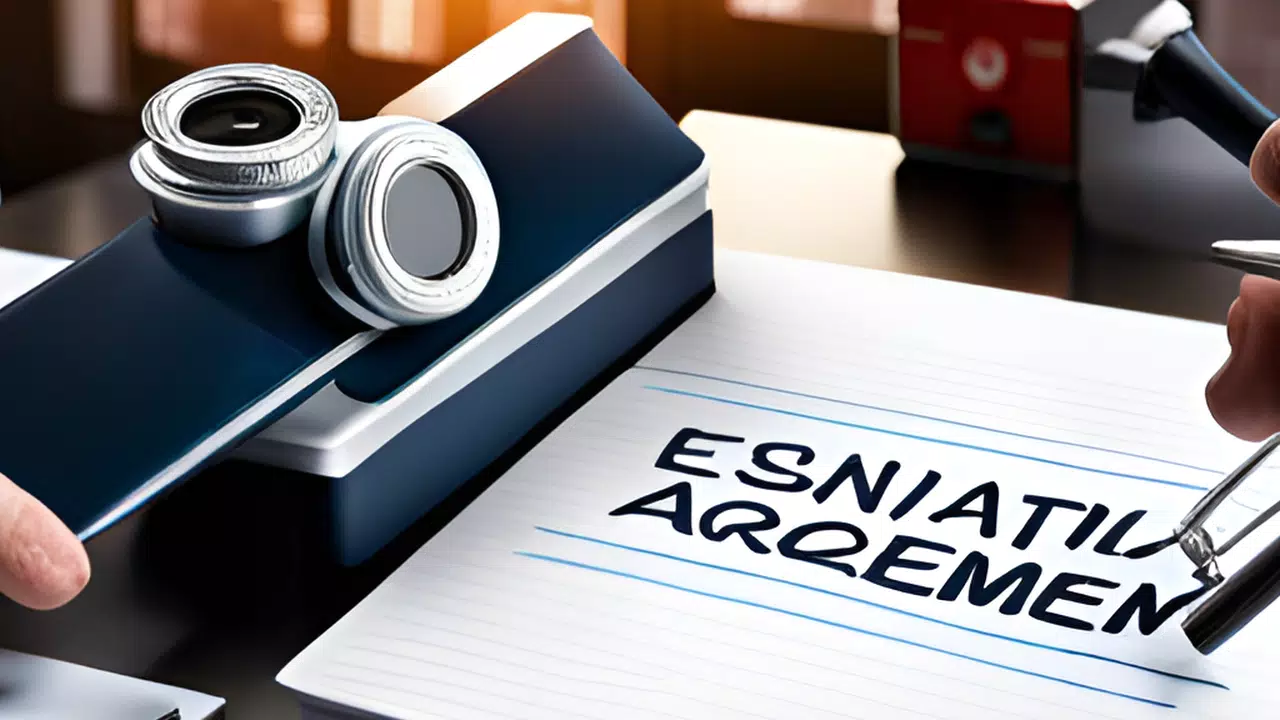
Understanding Loan Agreements
Loan agreements play a crucial role in business, as they offer a legal structure for borrowing assets. Knowing the intricacies of loan agreements can enable entrepreneurs to make wise choices and sidestep possible problems.
A loan agreement is a legal contract between two parties, the grantor and the mortgagor. The grantor is the party that lends the assets, while the mortgagor is the party that borrows the assets. The purpose of a loan agreement is to establish the terms and conditions of the loan, including the interest rate, the repayment schedule, and the consequences of default.
The Two Parties Involved
The grantor is the party that lends the assets, while the mortgagor is the party that borrows the assets. The grantor can be a bank, a financial institution, or an individual. The mortgagor can be a business, an individual, or a government entity. The grantor is responsible for ensuring the creditworthiness of the mortgagor and their ability to repay the loan. The mortgagor is obligated to use the assets for their intended purpose and to repay the loan according to the terms and conditions set forth in the loan agreement.
Common Uses
Loan agreements are commonly used for a variety of purposes, such as establishing a registered office, purchasing equipment, or financing a real estate transaction. In the case of a registered office, the loan agreement may be used to finance the purchase of the property or the construction of the building. For equipment financing, the loan agreement can facilitate the purchase or leasing of the necessary equipment. When it comes to real estate transactions, the loan agreement can provide funding for the acquisition or development of the property.
Types of Assets
Loan agreements can be used to borrow both movable and immovable assets. Movable assets are assets that can be easily transported, such as equipment, vehicles, or inventory. Immovable assets are assets that cannot be easily transported, such as real estate or buildings. The type of asset that can be borrowed through a loan agreement depends on the purpose of the loan and the creditworthiness of the borrower.
In conclusion, loan agreements are a critical aspect of business as they offer a legal structure for borrowing assets. Understanding the purpose of a loan agreement, the two parties included, its typical uses, and the types of assets that can be borrowed can help entrepreneurs make informed decisions and sidestep potential problems.

Essential Components of a Loan Agreement
A well-crafted loan agreement is essential for ensuring a smooth borrowing process. To create an effective agreement, it's crucial to include all the necessary components that clearly outline the terms and conditions.
Information about the contracting parties
The first essential component of a loan agreement is information about the contracting parties. This includes the names and addresses of both the borrower and the lender. It's important to include this information to ensure that both parties are legally bound by the agreement. Additionally, it's important to include any relevant contact information, such as phone numbers and email addresses, to facilitate communication between the parties.
The object of the contract (asset being borrowed)
The second essential component of a loan agreement is the object of the contract, or the asset being borrowed. This could be anything from a car to a piece of real estate. Clearly identifying the borrowed asset is crucial to prevent any confusion or misunderstandings. It is also important to include relevant details about the asset, such as its condition and value.
Duration of the contract
The third essential component of a loan agreement is the duration of the contract. This includes the start and end dates of the loan, as well as any relevant payment schedules. It's important to clearly outline the duration of the loan to ensure that both parties are aware of their obligations and responsibilities.
Obligations of both parties (grantor and mortgagor)
The fourth essential component of a loan agreement is the obligations of both parties, or the grantor and mortgagor. This includes the terms of the loan, such as the interest rate, payment schedule, and any penalties for late payments. It's important to clearly outline the obligations of both parties to ensure that there are no misunderstandings or disputes.
Force majeure clause, final clauses regarding possible disputes
The fifth essential component of a loan agreement is the force majeure clause, as well as any final clauses regarding possible disputes. The force majeure clause outlines any unforeseen circumstances that may prevent one or both parties from fulfilling their obligations under the agreement. Additionally, it's important to include any final clauses regarding possible disputes, such as the jurisdiction in which any disputes will be resolved.
Signatures of the parties
The final essential component of a loan agreement is the signatures of the parties. Both the borrower and the lender must sign the agreement to make it legally binding. It's important to ensure that both parties have read and understood the agreement before signing it.
In conclusion, a well-crafted loan agreement is essential for ensuring a smooth borrowing process. By including all the necessary components, such as information about the contracting parties, the object of the contract, and the obligations of both parties, borrowers and lenders can avoid misunderstandings and disputes. Additionally, it's important to ensure that both parties have read and understood the agreement before signing it to make it legally binding.

Advantages and Challenges of Loan Agreements
While loan agreements offer numerous benefits to entrepreneurs, they also come with certain challenges. A balanced analysis of these advantages and drawbacks can help business owners make informed decisions about whether to enter into such an agreement.
Advantages
One of the most significant advantages of loan agreements is that they are typically free of charge. Unlike other types of financing, such as equity financing, loans do not require business owners to give up ownership or control of their company. Additionally, loan agreements do not require registration or declaration, which can save entrepreneurs time and money.
Another advantage of loan agreements is that they do not come with an obligation for wear and tear compensation. This means that business owners who take out a loan are not required to compensate the lender for any wear and tear that occurs on the borrowed funds.
Challenges
One of the main challenges of loan agreements is that the borrower is responsible for any loss or damage that occurs to the borrowed funds. This means that if the funds are lost or damaged, the borrower will be required to compensate the lender for the full amount of the loan.
Another challenge of loan agreements is the risk of hidden defects. If the borrower discovers a defect in the borrowed funds after the loan has been granted, they may be required to compensate the lender for any damages that result from the defect.
Finally, loan agreements may be terminated in the event of the borrower's death. This means that if the borrower passes away before the loan has been fully repaid, the lender may be entitled to seize any assets that were used as collateral for the loan.
Weighing the Pros and Cons Based on Individual Circumstances
When considering whether to enter into a loan agreement, it is important for business owners to weigh the pros and cons based on their individual circumstances. Factors such as the amount of the loan, the interest rate, and the repayment terms should all be taken into account when making a decision.
It is also important for business owners to consider their ability to repay the loan. If the borrower is unable to make the required payments, they may be at risk of defaulting on the loan, which can have serious consequences for their credit score and financial future.
In conclusion, loan agreements offer numerous benefits to entrepreneurs, but they also come with certain challenges. By carefully weighing the pros and cons based on their individual circumstances, business owners can make informed decisions about whether to enter into such an agreement.

Drafting and Finalizing a Loan Agreement
Creating an effective loan agreement requires careful planning and attention to detail. By following a systematic process, entrepreneurs can ensure that their agreements are legally sound and fulfill their intended purpose.
When drafting and finalizing a loan agreement, there are several key points to consider:
Researching the legal requirements for loan agreements
Before drafting a loan agreement, it is essential to research the legal requirements for such agreements in your jurisdiction. This includes understanding the relevant laws and regulations that govern loan agreements, as well as any specific requirements that may apply to your particular situation.
For example, in the United States, loan agreements are typically governed by state law, but there may also be federal laws that apply, such as the Truth in Lending Act. In addition, some states may require that loan agreements be in writing and signed by all parties.
Consulting with legal and financial experts, if necessary
Depending on the complexity of the loan agreement, it may be advisable to consult with legal and financial experts to ensure that all legal and financial aspects are covered. This may include consulting with an attorney to review the agreement and ensure that all necessary provisions are included, as well as consulting with a financial advisor to ensure that the terms of the loan are financially feasible.
Drafting the agreement according to the essential components discussed earlier
Once all legal and financial requirements have been researched and the necessary experts consulted, it's time to draft the loan agreement. This document typically includes several essential components, such as:
- Loan amount and interest rate: This specifies the amount of the loan and the interest rate that will be charged.
- Repayment terms: This specifies the repayment schedule, including the amount and frequency of payments.
- Collateral: This specifies any collateral that is being used to secure the loan.
- Default and remedies: This specifies what happens if the borrower defaults on the loan and what remedies are available to the lender.
Reviewing and revising the agreement as needed
Once the loan agreement has been drafted, it's crucial to review and edit it as necessary to ensure all essential clauses are included and all legal and financial obligations are met. This may entail multiple revision rounds and consultations with legal and financial specialists.
Obtaining signatures from both parties
Once the loan agreement has been finalized, it is important to get signatures from both parties to indicate their agreement to the terms of the loan. This may involve signing the agreement in the presence of a notary public or other authorized individual.
Submitting the agreement to relevant authorities, if required (e.g., ONRC for company registration)
Finally, if required by law or regulation, the loan agreement may need to be submitted to relevant authorities for approval or registration. For example, in some jurisdictions, loan agreements involving companies may need to be registered with the relevant business registry, such as the ONRC in Romania.
In conclusion, drafting and finalizing a loan agreement requires careful attention to legal and financial requirements, as well as a systematic approach to drafting and revising the agreement. By following these key points, entrepreneurs can ensure that their loan agreements are legally sound and fulfill their intended purpose.
